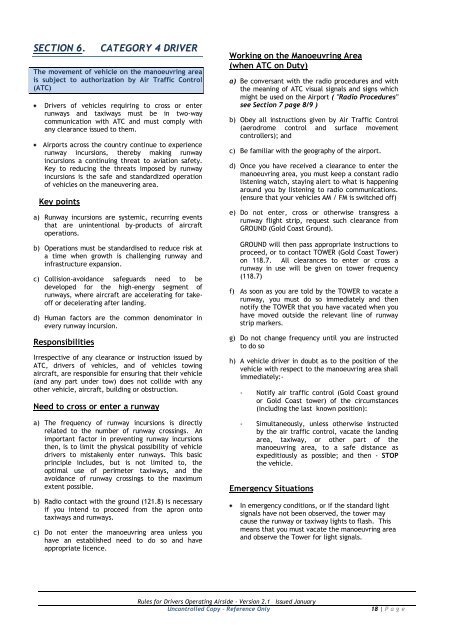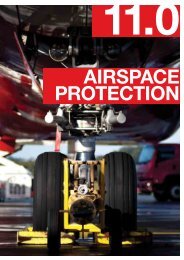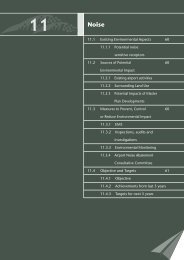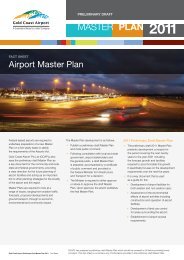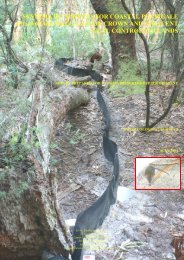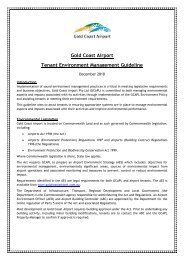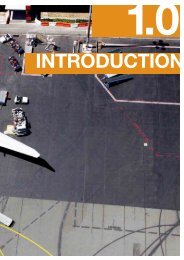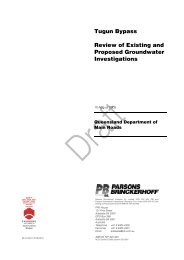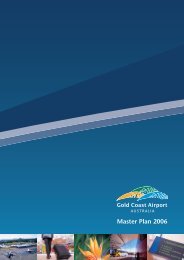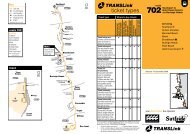GCA SAF – 104 Version 2.1: Issued January - Gold Coast Airport
GCA SAF – 104 Version 2.1: Issued January - Gold Coast Airport
GCA SAF – 104 Version 2.1: Issued January - Gold Coast Airport
You also want an ePaper? Increase the reach of your titles
YUMPU automatically turns print PDFs into web optimized ePapers that Google loves.
SECTION 6.<br />
CATEGORY 4 DRIVER<br />
The movement of vehicle on the manoeuvring area<br />
is subject to authorization by Air Traffic Control<br />
(ATC)<br />
Drivers of vehicles requiring to cross or enter<br />
runways and taxiways must be in two-way<br />
communication with ATC and must comply with<br />
any clearance issued to them.<br />
<strong>Airport</strong>s across the country continue to experience<br />
runway incursions, thereby making runway<br />
incursions a continuing threat to aviation safety.<br />
Key to reducing the threats imposed by runway<br />
incursions is the safe and standardized operation<br />
of vehicles on the maneuvering area.<br />
Key points<br />
a) Runway incursions are systemic, recurring events<br />
that are unintentional by-products of aircraft<br />
operations.<br />
b) Operations must be standardised to reduce risk at<br />
a time when growth is challenging runway and<br />
infrastructure expansion.<br />
c) Collision-avoidance safeguards need to be<br />
developed for the high-energy segment of<br />
runways, where aircraft are accelerating for takeoff<br />
or decelerating after landing.<br />
d) Human factors are the common denominator in<br />
every runway incursion.<br />
Responsibilities<br />
Irrespective of any clearance or instruction issued by<br />
ATC, drivers of vehicles, and of vehicles towing<br />
aircraft, are responsible for ensuring that their vehicle<br />
(and any part under tow) does not collide with any<br />
other vehicle, aircraft, building or obstruction.<br />
Need to cross or enter a runway<br />
a) The frequency of runway incursions is directly<br />
related to the number of runway crossings. An<br />
important factor in preventing runway incursions<br />
then, is to limit the physical possibility of vehicle<br />
drivers to mistakenly enter runways. This basic<br />
principle includes, but is not limited to, the<br />
optimal use of perimeter taxiways, and the<br />
avoidance of runway crossings to the maximum<br />
extent possible.<br />
b) Radio contact with the ground (121.8) is necessary<br />
if you intend to proceed from the apron onto<br />
taxiways and runways.<br />
c) Do not enter the manoeuvring area unless you<br />
have an established need to do so and have<br />
appropriate licence.<br />
Working on the Manoeuvring Area<br />
(when ATC on Duty)<br />
a) Be conversant with the radio procedures and with<br />
the meaning of ATC visual signals and signs which<br />
might be used on the <strong>Airport</strong> ( "Radio Procedures"<br />
see Section 7 page 8/9 )<br />
b) Obey all instructions given by Air Traffic Control<br />
(aerodrome control and surface movement<br />
controllers); and<br />
c) Be familiar with the geography of the airport.<br />
d) Once you have received a clearance to enter the<br />
manoeuvring area, you must keep a constant radio<br />
listening watch, staying alert to what is happening<br />
around you by listening to radio communications.<br />
(ensure that your vehicles AM / FM is switched off)<br />
e) Do not enter, cross or otherwise transgress a<br />
runway flight strip, request such clearance from<br />
GROUND (<strong>Gold</strong> <strong>Coast</strong> Ground).<br />
GROUND will then pass appropriate instructions to<br />
proceed, or to contact TOWER (<strong>Gold</strong> <strong>Coast</strong> Tower)<br />
on 118.7. All clearances to enter or cross a<br />
runway in use will be given on tower frequency<br />
(118.7)<br />
f) As soon as you are told by the TOWER to vacate a<br />
runway, you must do so immediately and then<br />
notify the TOWER that you have vacated when you<br />
have moved outside the relevant line of runway<br />
strip markers.<br />
g) Do not change frequency until you are instructed<br />
to do so<br />
h) A vehicle driver in doubt as to the position of the<br />
vehicle with respect to the manoeuvring area shall<br />
immediately:-<br />
- Notify air traffic control (<strong>Gold</strong> <strong>Coast</strong> ground<br />
or <strong>Gold</strong> <strong>Coast</strong> tower) of the circumstances<br />
(including the last known position):<br />
- Simultaneously, unless otherwise instructed<br />
by the air traffic control, vacate the landing<br />
area, taxiway, or other part of the<br />
manoeuvring area, to a safe distance as<br />
expeditiously as possible; and then - STOP<br />
the vehicle.<br />
Emergency Situations<br />
In emergency conditions, or if the standard light<br />
signals have not been observed, the tower may<br />
cause the runway or taxiway lights to flash. This<br />
means that you must vacate the manoeuvring area<br />
and observe the Tower for light signals.<br />
Rules for Drivers Operating Airside - <strong>Version</strong> <strong>2.1</strong> <strong>Issued</strong> <strong>January</strong><br />
Uncontrolled Copy <strong>–</strong> Reference Only<br />
18 | P a g e


